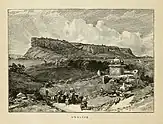Battle of Gwalior (1740)
The Battle of Gwalior took place between Jat ruler of Gohad and Mughal Governor Ali Khan. After the death of Aurangzeb, the Mughal Empire becomes weak and Maharaja Bhim Singh Rana attacked on Gwalior and captured it from Mughals.

| Battle of Gwalior | |||||||||
|---|---|---|---|---|---|---|---|---|---|
| Part of Mughal-Jat Wars | |||||||||
| |||||||||
| Belligerents | |||||||||
| Kingdom of Gohad | Mughal Empire | ||||||||
| Commanders and leaders | |||||||||
| Bhim Singh Rana |
Kiledar Kishwar Ali Khan | ||||||||
Background
After the death of the Mughal emperor Aurangzeb, the Mughal Empire began to decline economically and militarily. The Jats were among a number of groups who sought to fill this power vacuum. In 1740, Bhim Singh Rana marched on Gwalior Fort. The Mughal satrap Ali Khan surrendered the fortress to the Jat forces.
Battle
In 1740, Bhim Singh Rana the Jat ruler of gohad decided to take gwalior fort from mughal governor Ali Khan. He attacked on gwalior but marathas also want to take gwalior. Ali Khan Surrender gwalior fort to Jats and there are several battle fought between Jats and marathas for gwalior. But Jats win and gwalior came under Jats. Bhim Singh Rana occupied from 1740 to 1756.
Aftermath
The battle marked the end of Mughal rule in Gwalior. In 1756, the Marathas took eventual control of Gwalior.
See also
References
- McClenaghan, Tony (1996). Indian Princely Medals: A Record of the Orders, Decorations, and Medals of the Indian Princely States (illustrated ed.). Lancer Publishers. p. 131. ISBN 9781897829196.
- Misra, B. D. (1993). Forts and Fortresses of Gwalior and Its Hinterland (illustrated ed.). Manohar Publishers and Distributors. p. 148. ISBN 9788173040474.
External links
- Bhim Singh at History Files